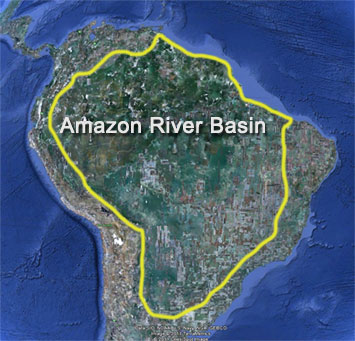John Roach
for National Geographic News
for National Geographic News
June 18, 2007
The Amazon River, not the Nile, is the longest in the world, a team of Brazilian scientists claims.
The scientists claim to have traced the river's source to a snow-capped mountain in southern Peru, adding a new twist in the swirling debate over the longest river label. (See a map of the region.)
The Amazon is considered the world's largest river by volume, but scientists have believed it is slightly shorter than Africa's Nile.
The Brazilian scientists' 14-day expedition extended the Amazon's length by about 176 miles (284 kilometers), making it 65 miles (105 kilometers) longer than the Nile.
According to the team's results, which have not been published, the Amazon is 4,225 miles (6,800 kilometers) long. The Nile stretches 4,160 miles (6,695 kilometers).
(See related: "Amazon River Once Flowed the Other Way, Study Says" [October 25, 2006].)
"Today, we can consider the Amazon the longest river in the world," study author Guido Gelli, director of science at the Brazilian Institute of Geography and Statistics, told London's Telegraph newspaper.
Long Rivalry
The Amazon and the Nile have been at the center of a centuries-old rivalry over the "world's longest" title.
In the 20th century, consensus gave the title to the Nile.
Determining the length of a river is tricky because scientists have to pinpoint both where the river begins and ends, Andrew Johnston, a geographer at the Smithsonian's National Air and Space Museum in Washington, D.C., told National Geographic News.



 At its widest point the Amazon River can be 11km/6.8 mi wide during the dry season. The area covered by the Amazon River and its tributaries more than triples over the course of a year. In an average dry season 110,000 square km of land are water-covered, while in the wet season the flooded area of the Amazon Basin rises to 350,000 square km. When the flood plains and the Amazon River Basin flood during the rainy season the Amazon River can be up to 40km/24.8 mi wide. Where the Amazon opens at its estuary the river is over 325km/202 mi wide!
At its widest point the Amazon River can be 11km/6.8 mi wide during the dry season. The area covered by the Amazon River and its tributaries more than triples over the course of a year. In an average dry season 110,000 square km of land are water-covered, while in the wet season the flooded area of the Amazon Basin rises to 350,000 square km. When the flood plains and the Amazon River Basin flood during the rainy season the Amazon River can be up to 40km/24.8 mi wide. Where the Amazon opens at its estuary the river is over 325km/202 mi wide! of the natural world. Have you ever seen a catfish? They're usually found in warm, slow moving waters of lakes and streams, and some people keep them as pets in aquariums. Catfish are pretty creepy looking fish with big flat heads and "whiskers" on either side of their heads (hence the name, catfish). Most catfish that we're familiar with here in the U.S. are anywhere from eight inches long to about five feet, weighing in at up to 60 pounds. But the catfish that live in the world's greatest river have all the room in the world to grow as big as nature will allow - they have been captured weighing over 200 pounds! One of the largest freshwater fish in the world is found living in the waters of the Amazon River. Arapaima, also known locally as Pirarucu, Arapaima gigas are the some of the largest, exclusively fresh water fish in the world. They have been found to reach a length of 15 ft/4m and can weigh up to 440lbs/200kg. (
of the natural world. Have you ever seen a catfish? They're usually found in warm, slow moving waters of lakes and streams, and some people keep them as pets in aquariums. Catfish are pretty creepy looking fish with big flat heads and "whiskers" on either side of their heads (hence the name, catfish). Most catfish that we're familiar with here in the U.S. are anywhere from eight inches long to about five feet, weighing in at up to 60 pounds. But the catfish that live in the world's greatest river have all the room in the world to grow as big as nature will allow - they have been captured weighing over 200 pounds! One of the largest freshwater fish in the world is found living in the waters of the Amazon River. Arapaima, also known locally as Pirarucu, Arapaima gigas are the some of the largest, exclusively fresh water fish in the world. They have been found to reach a length of 15 ft/4m and can weigh up to 440lbs/200kg. (



 Ramanujan kept a record of his ideas in a set of notebooks, and some of these ideas he sent in a letter to a respected mathematician in England, Godfrey Hardy. Hardy at first was tempted to throw away the letter, because the ideas it contained were seemingly just a collection of already well-known mathematical theorems. However, when he eventually took a closer look at Ramanujan's letter, he realized that these ideas had been developed by the young mathematician completely on his own, without any mathematical training. More importantly, he discovered that Ramanujan had included 120 theorems that were completely unknown to Western mathematicians, and Hardy had never seen anything like them. Some of them he couldn't even understand.
Ramanujan kept a record of his ideas in a set of notebooks, and some of these ideas he sent in a letter to a respected mathematician in England, Godfrey Hardy. Hardy at first was tempted to throw away the letter, because the ideas it contained were seemingly just a collection of already well-known mathematical theorems. However, when he eventually took a closer look at Ramanujan's letter, he realized that these ideas had been developed by the young mathematician completely on his own, without any mathematical training. More importantly, he discovered that Ramanujan had included 120 theorems that were completely unknown to Western mathematicians, and Hardy had never seen anything like them. Some of them he couldn't even understand.

